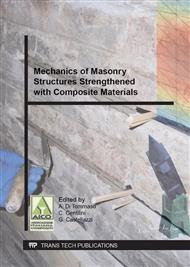[1]
S. Russo, F. Sciarretta (2012), Experimental and Theoretical Investigation on Masonry after High Temperature Exposure, in EXPERIMENTAL MECHANICS, vol. 52, pp.341-359, ISSN: 0014-4851, doi: 10. 1007/s11340-011-9493-0.
DOI: 10.1007/s11340-011-9493-0
Google Scholar
[2]
S. Russo, F. Sciarretta (2013), Masonry exposed to high temperatures: mechanical behaviour and properties - An overview, in FIRE SAFETY JOURNAL 2012, DOI: 10. 1016/j. firesaf. 2012. 10. 001.
DOI: 10.1016/j.firesaf.2012.10.001
Google Scholar
[3]
Guidelines for the evaluation and mitigation of seismic risk to cultural heritage with reference to the Italian Technical Code for constructions NTC 2008). Italian Ministry of Cultural Heritage and Activities, 2/12/(2010).
Google Scholar
[4]
G. Boscato, G. Riva, S. Russo, F. Sciarretta (2011).
Google Scholar
[5]
G. Boscato, A. Dal Cin, S. Russo, F. Sciarretta (2014). SHM of Historic Damaged Churches. Advanced Materials Research , 838-841, p.2071-(2078).
DOI: 10.4028/www.scientific.net/amr.838-841.2071
Google Scholar
[6]
Russo, S. 2012, Testing and modelling of dynamic out-of-plane behaviour of the historic masonry façade of Palazzo Ducale in Venice, Italy, Engineering Structures, 46, 2013, 130– 139 [DOI 10. 1016/j. engstruct. 2012. 07. 032.
DOI: 10.1016/j.engstruct.2012.07.032
Google Scholar
[7]
Pau, A., Vestroni, F. Vibration assessment and structural monitoring of the Basilica of Maxentius in Rome, Mechanical Systems and Signal Processing 41 (1-2), pp.454-466.
DOI: 10.1016/j.ymssp.2013.05.009
Google Scholar
[8]
De Stefano A, Ceravolo R. Assessing the health state of ancient structures: the role of vibrational tests. Journal of Intelligent Material Systems and Structures 2007; 18: 793–807.
DOI: 10.1177/1045389x06074610
Google Scholar
[9]
Milani, G., Russo, S., Pizzolato, M., Tralli, A., Seismic Behavior of the San Pietro di Coppito Church Bell Tower in L'Aquila, Italy, 2012, Open Civil Engineering Journal 6 (SPEC. ISS. 1) , pp.131-147.
DOI: 10.2174/1874149501206010131
Google Scholar
[10]
G. Boscato, M. Pizzolato, S. Russo, A. Tralli (2012), Seismic Behaviour of a Complex Historical Church in L'Aquila, in INTERNATIONAL JOURNAL OF ARCHITECTURAL, ISSN: 1558-3066, doi: 10. 1080/15583058. 2012. 736013.
DOI: 10.1080/15583058.2012.736013
Google Scholar
[11]
S. Russo (2012), On the monitoring of historic Anime Sante church damaged by earthquake in L'Aquila, in Structural control and health monitoring, ISSN: 1545-2263, doi: 10. 1002/stc. 1531.
DOI: 10.1002/stc.1531
Google Scholar
[12]
G. Boscato, D. Rocchi, S. Russo (2012).
Google Scholar
[13]
Doglioni F., Moretti A., Petrini V. Le chiese e il terremoto. Edizioni Lint. Trieste; 1994 [in italian].
Google Scholar



